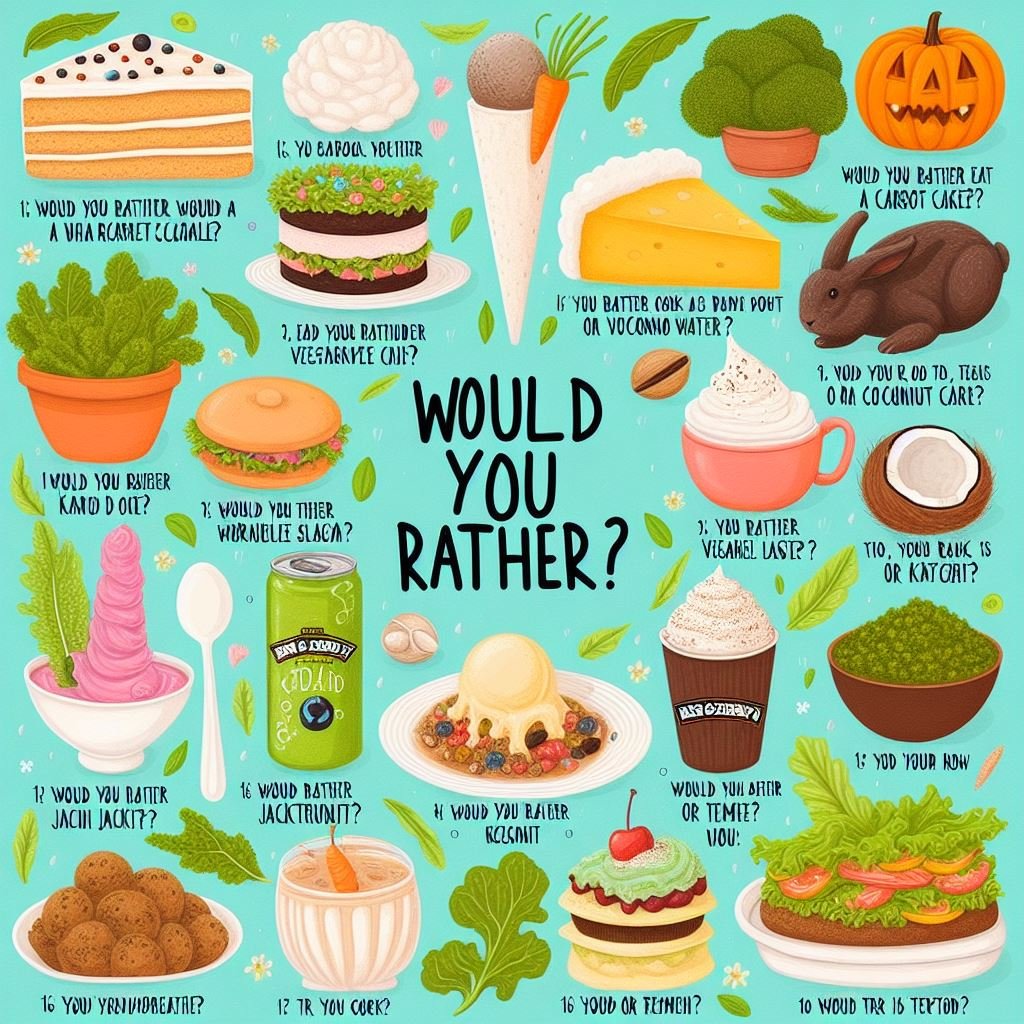Organizing a “Would You Rather” tournament turns a simple parlor game into an exhilarating, competitive event that tests players’ instincts, persuasion skills, and group dynamics. Whether you’re hosting among friends, at a company retreat, or as a fundraiser, a structured tournament amplifies engagement, fosters camaraderie, and creates memorable moments. In this comprehensive guide, you’ll learn:
-
Benefits of a tournament format
-
Formats & structures—brackets, Swiss, round‑robin
-
Planning steps—from invitations to prize design
-
Question curation—balancing difficulty, theme, and fairness
-
Scoring systems—objective, audience‑voted, hybrid
-
Logistics—venue, materials, scheduling
-
Engagement strategies—commentary, livestreaming, social media
-
Variations & twists—team play, sudden death, “dark horse” rounds
-
Sample timeline for a 3‑hour event
-
Post‑tournament follow‑up—awards, feedback, highlights
Let’s dive in!
Why a Tournament? Key Benefits
| Benefit | Description |
|---|---|
| Heightened excitement | Bracket progression and elimination rounds build suspense and stakes. |
| Inclusive competition | Players of all ages and backgrounds can compete on equal footing—no special skills required. |
| Team building | Collaborative formats foster communication, persuasion, and group identity. |
| Fundraising potential | Entry fees, sponsorships, and concessions can raise money for causes. |
| Replayability | A tournament structure can be reused with new questions, themes, or formats. |
| Social sharing | Brackets, highlights, and upsets make great social‑media content. |
Choosing a Tournament Structure
1. Single-Elimination Bracket
-
How it works: Lose once, and you’re out. Winners advance until a champion remains.
-
Pros: Simple, fast, high drama.
-
Cons: Early elimination means less playtime for some.
-
Ideal for: 8–32 participants, 1–2 hour events.
2. Double-Elimination Bracket
-
How it works: Players get a second chance via a losers’ bracket.
-
Pros: Fairer—one bad round doesn’t eliminate you.
-
Cons: More rounds, longer time needed.
-
Ideal for: 16–64 participants, 2–3 hour events.
3. Round-Robin Pools + Knockout
-
How it works: Participants divided into small groups; top performers from each group advance to single/double elimination.
-
Pros: Guaranteed multiple games per player; balances fairness and excitement.
-
Cons: Requires more organization and time.
-
Ideal for: Large groups (20+), multi-hour or multi-day events.
4. Swiss System
-
How it works: Players compete in fixed number of rounds against opponents with similar records; top scorers win.
-
Pros: No one is eliminated; accurate ranking.
-
Cons: Complex pairing and scoring.
-
Ideal for: Competitive gaming communities, 30+ players, 3+ rounds.
Step‑by‑Step Planning
Step 1: Define Objectives & Audience
-
Casual fun vs. serious competition
-
Age range, group size, venue (home, office, conference hall, virtual).
-
Time available (1 hour vs. full afternoon).
Step 2: Recruit Participants
-
Send themed invitations (digital e‑cards, social media events).
-
Collect RSVPs and any special needs (accessibility, dietary).
-
Solicit entry fees or sponsorships if fundraising.
Step 3: Curate Question Bank
-
Quantity: ~ (number of participants × 2) questions for elimination rounds; extras for tiebreakers.
-
Categories: Silly, pop culture, ethical dilemmas, “dark horse” surprise rounds.
-
Difficulty gradient: Start easy, ramp to thought‑provoking.
-
Fairness check: Avoid culturally biased or overly obscure references.
-
Validation: Test questions on a small pilot group for clarity and balance.
Step 4: Design Brackets & Schedule
-
Use printable bracket templates or software (e.g., Challonge, BracketHQ).
-
Allocate time per match (2–3 minutes per question + discussion).
-
Build in breaks and buffer time (5–10 minutes each hour).
Step 5: Set Up Materials & Venue
-
Physical: Projector or large screen, microphones, tables, chairs in pods or circle.
-
Digital: Polling software (Mentimeter, Kahoot), livestream setup, scoreboard display.
-
Props: Branded banners, question cards, timers, buzzers.
-
Refreshments: Snack stations and drink bar to maintain energy.
Step 6: Establish Rules & Scoring
-
Basic play: Host reads question; players choose A or B; majority wins the round.
-
Scoring options:
-
Majority vote: Player in majority advances.
-
Point accumulation: Each correct “popular choice” earns a point.
-
Persuasion bonus: Audience votes best justification (bonus point).
-
-
Tiebreakers: Sudden‑death question, rock‑paper‑scissors, or “lightning round” of 3 rapid questions.
Step 7: Recruit Hosts & Judges
-
Main host: Reads questions, manages flow.
-
Timekeeper: Enforces timers.
-
Judges/panels: Resolve disputes, tally persuasion votes.
-
Scorekeeper: Updates bracket and scoreboard live.
Step 8: Promote Engagement
-
Live commentary (“play‑by‑play”) to hype key matchups.
-
Social media updates: photos, bracket progress, highlight clips.
-
Audience participation: cheer squads, “fan favorite” polls.
Step 9: Award Prizes & Recognition
-
Trophies/medals for champion, runner‑up.
-
Medals for best persuader, funniest answer, audience favorite.
-
Certificates or digital badges for all participants.
-
Swag: branded t‑shirts, mugs, gift cards.
Step 10: Post‑Event Follow‑Up
-
Share bracket results, photos, and highlight reel.
-
Collect feedback surveys for improvement.
-
Publish “Top 10 Moments” blog or newsletter.
-
Announce next tournament date to build anticipation.
Question Curation: Crafting Compelling Dilemmas
Balancing Elements
-
Humor vs. depth: Mix silly questions with serious ones to vary pacing.
-
Easy vs. challenging: Early rounds—quick, accessible; later rounds—deeper dilemmas.
-
Universal vs. niche: Ensure broad relatability; sprinkle in niche for spice.
Sample Questions by Round
| Round | Question Example | Purpose |
|---|---|---|
| 1 (Warm‑up) | Would you rather have a pet dragon or pet unicorn? | Quick, fun, no stress |
| 2 (Pop Culture) | Would you rather binge the new Marvel series or the new Star Wars series? | Engages fans, sparks debate |
| 3 (Ethical) | Would you rather tell a friend a harsh truth or a comforting lie? | Deeper values |
| 4 (Career) | Would you rather a high‑pay job you hate or dream job at half pay? | Relatable adult dilemma |
| 5 (Surprise “Dark Horse”) | Would you rather time‑travel to the past or teleport to the future? | Re‑energize before semis |
| 6 (Final) | Would you rather achieve world peace or cure all diseases? | Epic, thought‑provoking |
Scoring Systems Explained
A. Majority‑Vote Advancement
-
Mechanic: All players vote A or B; those in majority move on.
-
Simplicity: Easiest to run; encourages group cohesion.
B. Point‑Based Competition
-
Mechanic: Each correct guess of majority choice = 1 point. Top point-earners advance or win.
-
Benefit: Everyone plays every round; no immediate elimination.
-
Usage: Swiss format or round‑robin pools.
C. Persuasion & Debate Bonus
-
Mechanic: After initial vote, one player from minority can “debate” to sway votes; players switching sides earn bonus point.
-
Benefit: Rewards rhetoric and quick thinking; adds interactive drama.
D. Hybrid Systems
-
Combine point-based and elimination: top half by points advance to knockout.
-
Use persuasion bonus only in semifinal and final rounds for extra flair.
Logistics & Materials Checklist
| Category | Item |
|---|---|
| Venue Setup | Tables/chairs, projector/screen, microphones, speakers |
| Brackets & Score | Printed brackets, dry‑erase board, digital bracket software |
| Question Deck | Printed cards, index cards, or digital slides |
| Timing Tools | Stopwatch, smartphone timer, bells or buzzers |
| Refreshments | Snack bar, drink station, napkins, plates, cups |
| Staffing | Host, co‑host, timekeeper, scorekeeper, judges |
| Audience Engagement | Cheering props, fan signs, social media hashtags |
| Prizes & Swag | Trophies, medals, certificates, branded merchandise |
| Safety & Comfort | First‑aid kit, accessible seating, clear signage |
Engagement Strategies & Twists
1. Team vs. Team
-
Divide into teams; teams discuss and vote collectively.
-
Encourages collaboration; add team names, colors, chants.
2. “Dark Horse” Round
-
Mid‑tournament surprise: ultra‑tough or whimsical wildcard question.
-
Losers get second chance; winners get bonus point.
3. “Hot Seat” Lightning Round
-
Final two players face 5 rapid “Would You Rather” questions back‑to‑back.
-
Best of five wins championship.
4. Audience Lifelines
-
Players can “phone a friend” or use audience poll once per match.
-
Adds strategy and audience involvement.
5. Themed Tournaments
-
Decade themes: ’80s, ’90s, 2025 pop culture.
-
Genre themes: Horror, sci‑fi, romance.
-
Charity edition: Questions tied to cause; donations per round.
6. Live Streaming & Social Media
-
Broadcast matches on Twitch or Zoom; use chat polls for audience votes.
-
Post bracket updates, highlight clips, and “meme‑worthy” moments on Instagram and Twitter.
Sample 3‑Hour Tournament Timeline
| Time | Activity |
|---|---|
| 0:00–0:15 | Arrival & registration; distribute name tags & brackets |
| 0:15–0:30 | Opening ceremony & rules explanation; warm‑up round |
| 0:30–1:15 | Round 1: Single‑elimination (16 → 8 players) |
| 1:15–1:25 | Snack/drink break; audience “fan favorite” poll |
| 1:25–2:00 | Round 2: Quarterfinals (8 → 4 players) |
| 2:00–2:10 | Dark Horse wildcard round (re‑entry opportunity) |
| 2:10–2:40 | Semifinals (4 → 2 players) |
| 2:40–2:55 | Final lightning round; championship match |
| 2:55–3:00 | Awards presentation, closing remarks |
Post‑Tournament: Recognition & Reflection
-
Award Ceremony: Present trophies, medals, and fun superlatives (“Best Debater,” “Most Daring Choice”).
-
Highlight Reel: Share top quotes, funniest moments, and upset victories via email or social feed.
-
Feedback Survey: Quick form to gather suggestions—favorite questions, format tweaks, snack feedback.
-
Future Planning: Announce next tournament date/theme; invite volunteers for question curation.
Conclusion
A “Would You Rather” tournament elevates a simple conversational game into a structured, high‑energy competition that fosters connection, laughter, and strategic thinking. By carefully selecting a tournament format, curating balanced questions, and managing logistics—from brackets to snacks—you create an event that’s inclusive, replayable, and memorable. Engagement strategies like team play, persuasion bonuses, and live streaming turn passive spectators into active participants, while well‑timed breaks and thoughtful refreshment options keep energy high.
Whether you aim to build team spirit at work, raise funds for a cause, or simply host an unforgettable game night with friends, this guide equips you with everything you need. So draw your brackets, warm up your debating skills, and get ready to find out: Would you rather organize the ultimate tournament—or be crowned its champion?



